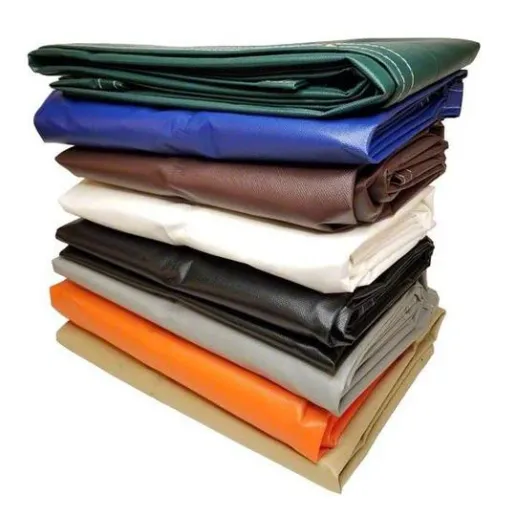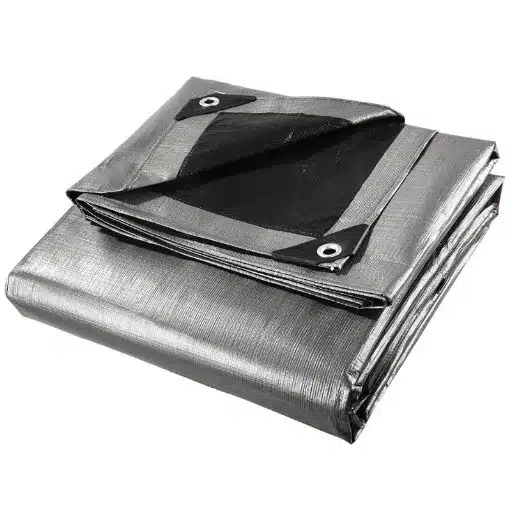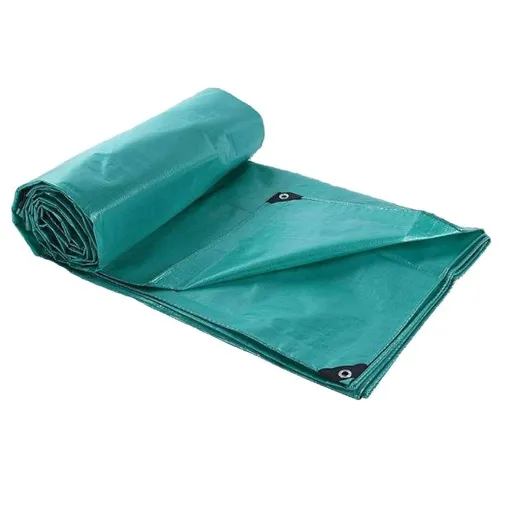Are you on the lookout for ways to increase the level of comfort and style in your home while simultaneously reducing heat indoors and shielding the outside area from the elements? Residential awnings may prove to be just the remedy. These all-purpose attractive canopies do increase the appeal of the house; they are practical, too, with protection from the sun, UV rays, and shade, besides energy efficiency. Awnings blend practicality with aesthetic appeal whether you are working towards the establishment of a relaxing outdoor space, shielding your windows from heavy sunlight, or complementing the polished looks of your patio. This article discusses benefits of residential awnings, designs offered, and suggestions tailored to aid you in selecting a suitable canopy for your home and lifestyle.
🏠
Understanding Residential Awnings
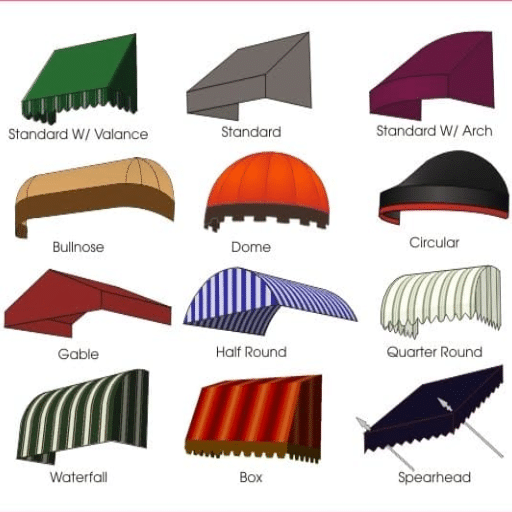
01
What Is a Residential Awning?
A residential awning is an extra layer of covering that is attached to a building’s exterior, typically over windows, doors, or patios, and that adds aesthetic and functional value. These structures are fabricated from durable materials like fabric, metal, or polycarbonate and supported by a frame that extends outward. The functions of residential awnings range from providing shade, lowering indoor temperature, and sheltering outdoor areas from harsh weather. In recent years, advancements of design and technology render most modern awnings retractable and made from UV-resistant fabric, which ultimately makes awnings the perfect choice to supplement energy saving and outdoor comfort.
02
Advantages of Installing Awnings for Homeowners
Awnings provide functional and aesthetic benefits. The major and primary benefit, however, is that it helps save some cost on energy. Recent studies have shown that by blocking out direct sunlight from the windows and warming up the interior space, awnings are capable of cutting cooling bills by up to 25%. Plus, awnings protect furniture, carpets, and outdoor amenities from sun damage caused by ultraviolet rays and thus lengthen their lifespan.
Energy Savings Highlight: Awnings can reduce cooling costs by up to 25% while protecting your interior furnishings from UV damage.
Now with the availability of retractable awnings, homeowners are free to configure their outdoor spaces to their comfort, thereby encouraging them to use their patios or decks more for leisure and socializing in all weather. Stylishly designed awnings also enhance the curb appeal, giving the property an added virtue for resale.
03
How Do Awnings Help in Energy Cost Reduction?
Awnings play an important energy conservation role by preventing direct sunlight from entering the house and heating it up. The window awnings, as per the U.S. Department of Energy, can cut solar heat gained by 77% for west-facing windows and 65% for south-facing windows. Keeping the indoor spaces cool naturally lets the homeowner turn less to air conditioning for some period during warm months, thus resulting in an observable reduction in energy bills. Moreover, retractable awnings can be opened during cold months to let sunlight through to warm the house, and then closed again during warm months, thereby optimizing energy use throughout the year. The combination of shading and adaptability will ensure a home that is both environmentally conscious and low on cost.
📋
Types of Awnings for Residential Use
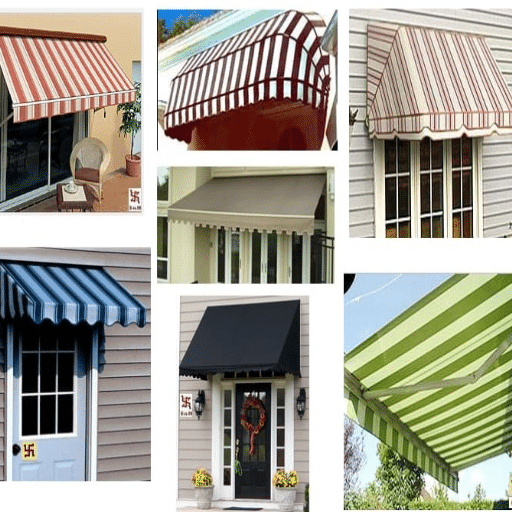
⚖️ Fixed Awnings vs. Retractable Awnings
🔒 Fixed Awnings
- ✓
Provide consistent shade and weather protection - ✓
More durable against harsh weather conditions - ✓
Perfect for year-round coverage needs - ⚠️
Cannot adapt to changing weather conditions
🔄 Retractable Awnings
- ✓
High level of freedom and convenience - ✓
Adapt to changing weather and seasonal demands - ✓
Perfect for outdoor living areas - 🔧
Available with motorized controls
Market Trend: According to recent search trends, motorized retractable awnings have been increasingly searched for by homeowners, reflecting a growing trend toward convenience and modern-day comfort.
🎨 Canopy Styles: Which One Fits Your Home?
📏 Choosing the Right Size for Your Space
The choice of the canopy size depends on the size of an outdoor space and its purpose. As per recent surveys and trends data from search engine, there has been an increase in demand for big canopies meant to cover entertaining or outdoor dining areas, with 10×10 feet, and 12×12 feet, being the most preferred sizes. For smaller patios or balconies, smaller sizes of 6×6 feet work best, while bigger areas may want to look at choosing custom-sized canopies or modular ones to be able to fit more guests or unique layouts.
🏠 Small Spaces
6×6 feet
🎪 Medium Areas
10×10 feet
🏟️ Large Spaces
12×12 feet+
Begin by measuring your available space and factoring in the placement of furniture and walking space to ensure that the canopy fits perfectly in providing comfort, style, and synergy for your outdoor needs.
🧵
Materials Used in Residential Awnings
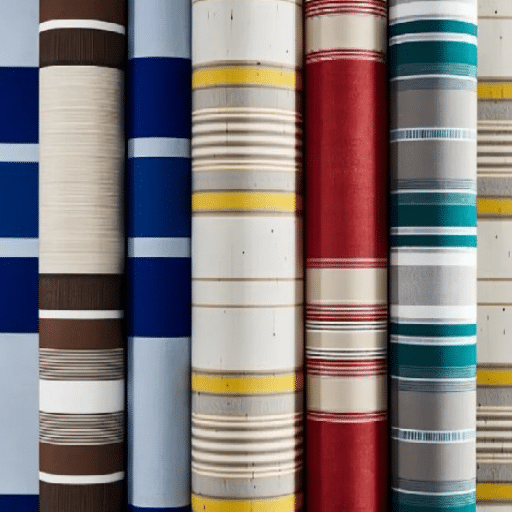
🎨 Popular Fabric Options for Awnings
The deciding factors for awning fabrics are durability, weather resistance, and style. Some acrylic fabrics are famous for their bright colors and resistance to fading, mildew, and moisture. They are ideal for long-term outdoor use in differing situations climates. Polyester blends, whose fabrics are frequently coated to enhance durability, weigh little and serve well as UV protection. These materials, therefore, present the cheaper route to versatility. Meanwhile, vinyl-coated fabrics are waterproof and can be kept clean with ease, making them a great option wherever heavy rains occur.
Eco-Friendly Trend: Search trends show more and more owners contemplating green options: recycled materials; fabrics treated with non-toxic coatings; etc.
By combining functionality with more contemporary appearance, these fabrics provide options for just about everybody while effectively enhancing the outdoor space.
🔨 Durable Frame Materials: Wood, Aluminum, and More
For a sturdy frame material to be used in outdoor furniture, wooden and aluminum varieties come to mind in most cases, since their longevity can be counted on and withstanding design versatility. Recent search data indicate strong trends favoring sustainable hardwood sources such as teak and eucalyptus. These are naturally weather-and-pest-resistant woods, physically fitting the spirit of green living. Unlike wood, aluminum is highly coveted for being lightweight and highly resistant to corrosion, offered in many modern finishes that suit very sleek contemporary designs in general.
🌳 Wood Options
Teak, Eucalyptus
⚡ Aluminum
Lightweight, Corrosion-resistant
♻️ Eco Options
Recycled Materials
Increasingly, consumers ask whether these materials adversely stand harsh environmental conditions, the answer, of course, depends: on treatment and maintenance. With properly treated wood and sealants, along with powder coating, aluminum performs quite well in longevity and will maintain its beauty and functionality over time. This is a rare blend of durability, eco-conscious design diversity, making them among the tallest standing options in the outdoor furniture solution today.
🌦️ Weather-Resistant Options for Longevity
To choose weather-resistant materials for outdoor use, search trends indicate an obvious gravitation towards such a feature that is long-lasting and does not require much maintenance. Common questions are: “What materials last best against UV rays, against rain, against very extreme temperatures?” The answer probably resides with materials purposely made for great endurance. Teak, for example, has natural oils that repel water and resist warping, while anodized aluminum does very well, being rust-proof and with a minimum level of so-called upkeep. If one wants to go greener, recycled plastic in the form of HDPE (High-Density Polyethylene) has exploded in popularity as the best candidate: great weather resistance and sustainability! Combined with proper maintenance, choosing the right materials guarantees that your outdoor furniture could face all kinds of hard situations, maintaining its appeal and functionality.
🔧
Installation Process for Residential Awnings
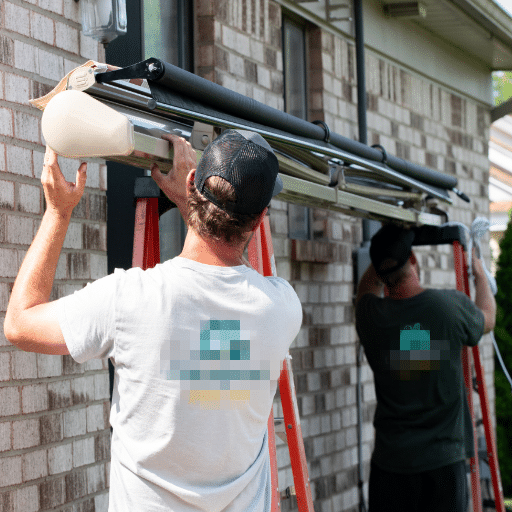
⚖️ DIY Installation Vs. Professional Help
When weighing up the cost of installation of residential awnings and its installation from DIY to cut-rate, factors like skills required, duration of suitability, and durability should be taken into account. If individuals have the appropriate skills, relevant tools, and time to spare, then a DIY awning installation can be more cost-efficient. There are many tutorials on the internet so that installing an awning may never have to be a big concern for anyone. Recent search-query trends show a strong interest in “how to install residential awnings,” suggesting an increasing confidence in this style of home improvement as a solo project. However, professionals are trained for precision fitting, installation, and alignment to make the awning well-secured against various environmental forces. Many professional services also offer warranties against their job completion, all assuring one-on-one peace of mind in the long run. Therefore, at the end of the day, it comes down to an individual’s belief in themselves or in paying the pros for good finish, reliability, and durability.
📋 How to Install a Retractable Awning?
Follow these step-by-step instructions for a safe and successful installation:
- 1
Select a Location
First, determine where you want to situate your retractable awning. Check whether the area is free of obstructions and does not hinder the free extension of the awning. Think about the direction of the sun and where your major structural support, such as a wall or roof overhang, will be.
- 2
Gather the Necessary Tools and Materials
Put together all the basic tools. They may include a drill, measuring tape, level, wrench, and screws or bolts that come with your awning kit. Having all the materials ready will make the installation flow easier.
- 3
Measure and Mark Your Mounting Points
Attain the correct measurement using the measuring tape. The brackets must be positioned evenly with one another and at the right position concerning the frame of the building; mark the areas with a pencil to use as a guide when drilling.
- 4
Mount the Brackets
First, drill holes at the points you have marked. Always include the brackets using screws or bolts provided; ensure that with a level, the brackets are straight and properly aligned.
- 5
Attach the Awning to the Brackets
With the assistance of another person, lift the awning and set it onto the mounted brackets. Follow all the manufacturer’s instructions carefully to ensure that all connections are properly made. Ensure that all bolts and screws are tightened.
- 6
Adjustment and Testing
Extend and retract the awning at least a dozen times to make sure it is running smoothly. Adjust its pitch or angle to your liking, and check that you are getting enough shade.
- 7
Final Inspection
Check again all the bolts and screws for alignments and stability. Make sure your awning is firmly secured and ready to withstand contamination during normal use.
Important Note: By following these steps, one will have a safe and working installation with the maximum long-term benefits from the retractable awning. If you do not feel confident at any stage in the process, call in a professional to do it for you.
⚠️ Important Things to Consider Before Installation
Several important points should be carefully considered when preparing for a retractable awning installation in order to achieve the greatest outcome. First, consider the structural conditions of the installation surface. The wall or any support should be optimally strong to support the awning depending on its weight, especially when weather conditions become hostile. After this, make accurate measurements of the available space and ensure that the chosen awning is suitable for that space without interfering with windows, doors, or nearby structures. Be mindful of the weather and climatic conditions of the location. For example, areas that get heavy wind or thunder may require awnings with extra reinforcements or extra protective features. Choice of materials can also make a huge difference; materials should be resistant to UV rays, mildew, and water for longevity and withstanding performance. Lastly, attend to any local laws or any laws by the home owners’ association which might have direct effects on the installation process or perhaps the kind of awning to be installed. Critically considering all these points, combined with a good plan, will instigate an easy installation, settling, and comfort of your outdoor area.
🧽
Maintenance Tips for Longevity
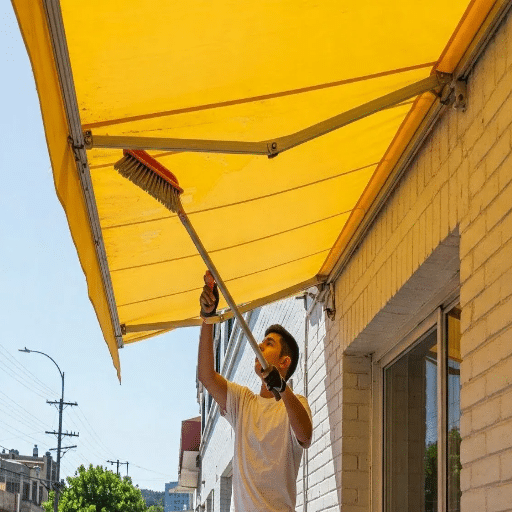
🧼 Cleaning Your Awning: Best Practices
Cleaning is necessary to maintain the awning’s appearance and durability. Start cleaning by removing loose debris from the awning fabric surface, using either a soft brush or broom. Use lukewarm water mixed with mild soap or a specialized cleaner for fabric awnings. Then, scrub gently with a soft-bristled brush; do not use any harsh chemicals as these could damage the fabric or its UV-resistant coating. Rinse well with clean water to wash away all soap residue, as soap build-up can cause discoloration after some time. For retractable awnings, it is advisable to have them fully extended during cleaning, allowing a good look at dirt accumulation along hinges or hardware. Always clean on a dry sunny day, so the awning may dry thoroughly with free air, thereby preventing any potential mold or mildew growth caused by residual dampness. These best arts will help bestow a longer life and retain brighter colors for your awning throughout the year.
🔍 Inspecting for Damage and Repairs
Keeping up with inspecting awnings for damage is a key factor in ensuring their functionality and looks. At first, start inspecting the awning fabric visually, looking for any signs that could jeopardize its durability, including holes, fraying, or discoloration. Consolidate inspection by focusing on seams and stitching since those areas are more likely to weaken over time. On the other hand, for retractable awnings, test mechanisms for any given unusual noises or resistance while extending and retracting. Likewise, hardware should be checked for rust or corrosion-greasy rust or corrosion and fasten those that are loosely fastened with rust-proof materials.
Search Trend Insight: Many users are searching for “how to extend the lifespan of awnings,” which attests to the priority of regular inspections and maintenance.
Tackling minor repairs early, such as patching up small holes and repairing or even replacing parts, will prevent awning deterioration. By being proactive, you can indeed extend the longevity of your awning, thereby lessening the chances of expensive repairs.
📅 Seasonal Maintenance Checklist
Essential maintenance tasks to perform throughout the year:
- 🔍
Inspect for Damage
At the beginning of each season, conduct an alert inspection for tears, holes, rusted parts, or loose fittings in your awning. Check for signs that sudden wear might demand immediate repair. Ongoing inspections can stave off damage from worsening over time.
- 🧽
Clean Thoroughly
Clean the fabric and frame using a mild soap and water solution. Avoid harsh chemicals that may degrade the materials used. According to research trends, most of the searches for “how to clean outdoor awnings” are made during spring, indicating that for homeowners, cleaning is a priority.
- 🔧
Lubricate Moving Parts
Check and lubricate hinges, cranks, and any other moving parts to ensure smooth operation. This step is often included when searching for “awning maintenance tips,” emphasizing it as crucial to proper function.
- 🌧️
Retract in Harsh Weather
Protect your awning during heavy rain or snow, or when it is too windy, by retracting it when not in use. Many users querying “how to protect awnings during storms” reiterate the importance of being proactive once the bad weather abates.
- ☀️
Reapply Protective Coatings
Extend the life span of your awning by reapplying UV-protective sprays or water-resistant coatings as necessary. The rise in searches for “UV protection for awnings” is evidence of users’ concerns about suns’ damaging effect on their awning material.
By infusing these seasonal maintenance tasks and considering the common concerns from search data, you will definitely keep your awning well maintained and in great condition throughout the year. This approach not only helps avert damage but is also backed by popular queries concerning awning durability.
🎨
Creative Design Ideas for Residential Awnings
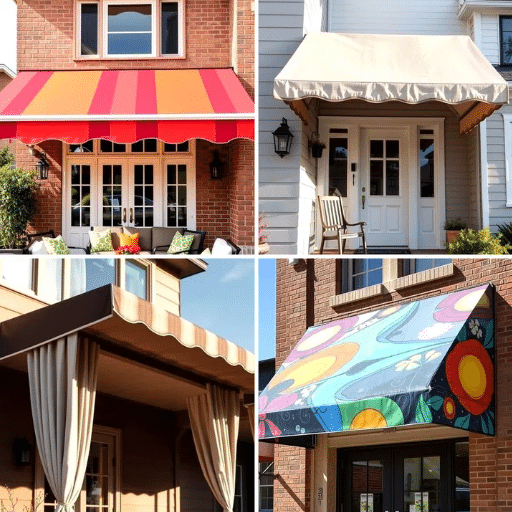
🌈 Choosing Colors that Match Your Home
Giving color to the residential awning will find some way to complement the view of the house and fit with an individual’s personal style. Search data lately shows an upward trend in queries such as “best awning colors for modern homes” and “neutral awning colors,” possibly indicating that people go for versatility and timeless design. Neutral hues like beige, gray, or navy blue sit well with nearly all exterior palettes, whereas more vivid colors like red or yellow may appeal to homeowners eager to make an artistic statement. To arrive at the perfect shade, take into consideration the existing color scheme of your house, the landscaping around it, as well as whether the awning will reflect or absorb natural light. Coordination of these factors will stand the test of times in both current design trend and personal taste.
✨ Accessorizing for Personal Style
Accessories make or break the outdoor awning, reflecting one’s own style while serving practical purposes. Options include decorative valances, LED strip lighting for ambiance, and integrated motorized systems requiring little effort to operate. According to trends, searches for “smart awning accessories” and “custom awning designs” have shot up recently, perhaps representing a growing need for technology to relate to personalization.
Trending Accessories: Decorative valances, LED lighting, motorized systems, weather-proof fabrics with bold patterns, and side panels for privacy.
And how does one personalize? Consider weather-proof fabrics with bold patterns or side panels for added privacy and additional shade. Merging snazzy upgrades with useful features will see your awning transformed into a design showcase and a functional extension of your outdoor living area that fulfills modern-day requirements while also being true to personal needs.
🏡 Maximizing Curb Appeal with Awnings
Good data from search trends recently reveal that homeowners are more concerned about curb appeal today than functionality. Awnings stand in the way of achieving this balance. For curb appeal, choose designs that are complementary to your home’s architectural style. For example, sleek, retractable awnings with neutral shades are i-the-moment for modern homes, while colorful striped awnings offer a quaint look for traditional or cottage-style homes. Smart technology integration itself brings the “wow” factor with motorized controls or remote operation, a level of convenience much sought after on the rise in the smart living arena. Thus, in combining aesthetics with usefulness continually backed by data, awnings will end up in raising through the neck of beauty and character of your home.

